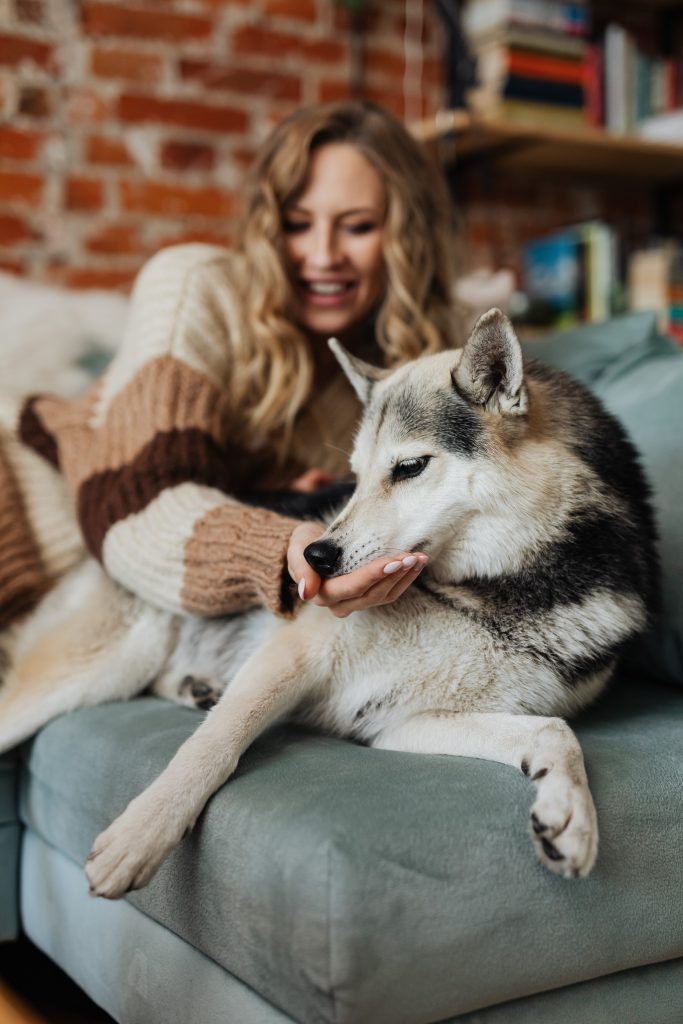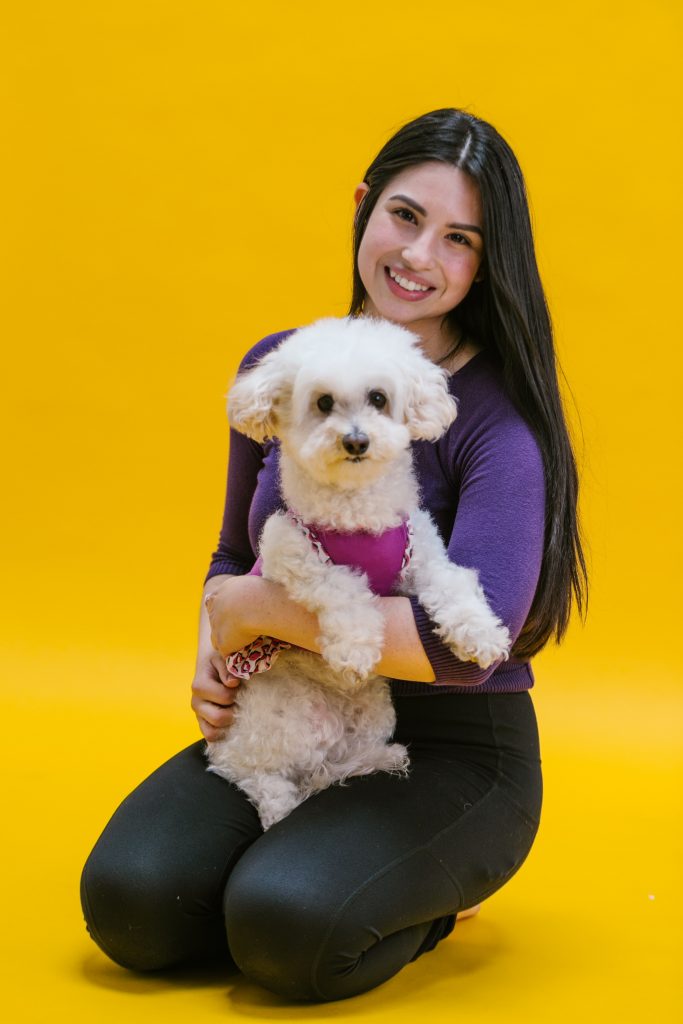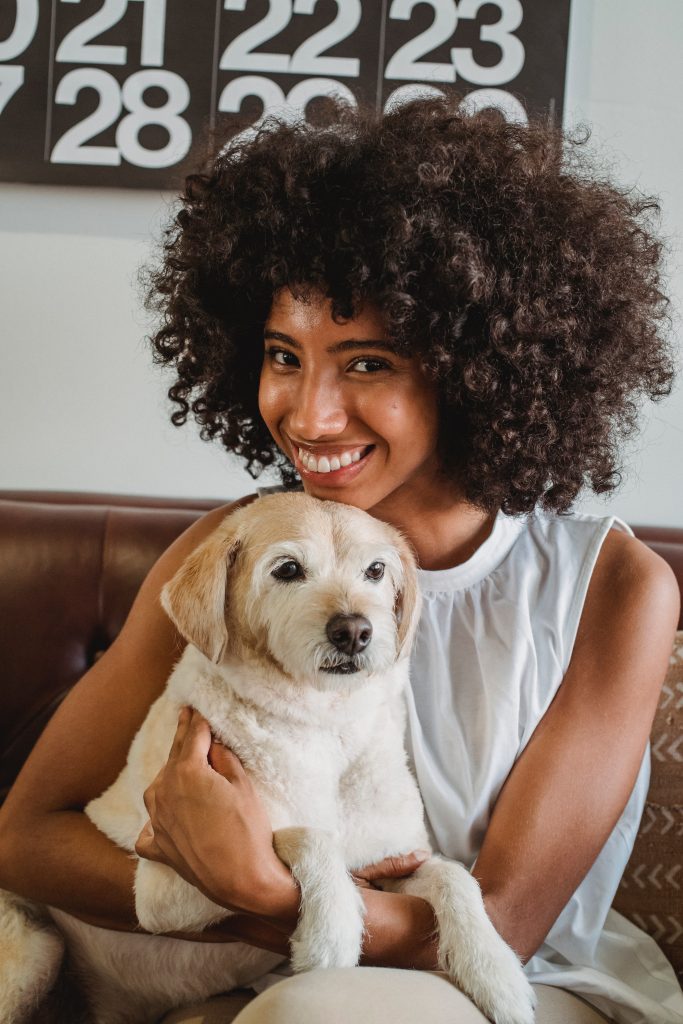Are you puzzled by why does my dog put his butt on me? This is actually a common behavioral trait in our canine friends, showing trust and seeking connection.
In this blog post, we will decode the reasons behind why dogs display this behavior and how it’s a sign of their affection towards us. Prepare to understand your pooch on a whole new level!

Key Takeaways
- Dogs push their butt against you to show affection, trust, and seek connection.
- Reasons why dogs do this include appeasement signaling, polite greetings (butt sniffing), creating physical contact for bonding, seeking comfort and security, and asking for attention or affection.
- Understanding your dog’s body language is important in responding properly to their behavior.
- Provide positive reinforcement, mental and physical stimulation, and seek professional guidance if needed.
The Reasons Why Dogs Push Their Butt Against You
Dogs push their butt against you for various reasons, including appeasement signaling, polite canine greeting (butt sniffing), creating physical contact for bonding, seeking comfort and security, and asking for attention or affection.
Appeasement Signaling
Dogs use this signal to say sorry or avoid trouble. They do not want a fight. This could be like when your dog does something bad, then pushes their butt against you. It’s a sign they feel safe with you and know they won’t get hurt.
Dogs also push their rear end on us to show they are calm and happy around us. If your dog sits next to you, butt first, it is showing love and trust in its own way.
Polite Canine Greeting (Butt Sniffing)
Dogs have a unique way of saying hello to each other. They sniff each other’s butts! While it may seem strange to us, this behavior is actually a polite canine greeting. When dogs sniff each other’s behinds, they are gathering important information about the other dog.
You see, dogs have scent glands in that area that release pheromones and give off different smells. By sniffing, they can learn things like the other dog’s diet, health, and even their mood.
So when your dog pushes their butt against you, it could be their way of politely saying hello and trying to gather information about you too!
Creating Physical Contact for Bonding
When your dog pushes their butt against you, it’s not just a random behavior. It’s actually their way of creating physical contact for bonding with you. By leaning into you or rubbing their rear end on you, they are seeking closeness and connection.
This action shows that they trust and feel secure around you, as well as wanting to strengthen the bond between you two. So the next time your furry friend does this, embrace the opportunity to cuddle up and enjoy some quality bonding time together!
Seeking Comfort and Security
Dogs often push their butts against their owners as a way to seek comfort and security. When a dog does this, it means they trust and feel safe with you. It’s like giving you a big hug! Your dog might do it when they’re feeling anxious or scared and need your reassurance.
By pressing their rear end against you, they’re seeking physical contact to help them feel calm and protected. So next time your furry friend leans on you, know that they are asking for your love and support.
Enjoy the special bond that you share!
Asking for Attention or Affection
Dogs often push their butt against you to ask for your attention or affection. It’s their way of saying, “Hey, I want some love!” This behavior is a clear sign that your dog wants to bond with you and spend quality time together.
By pushing their rear end on you, they are seeking physical contact and closeness. So the next time your furry friend does this, take it as an invitation for snuggles and pets!

Understanding Your Dog’s Body Language
Understanding your dog’s body language is essential for building a strong bond and effective communication. Dogs use their bodies to express their emotions and needs, so it’s important to pay attention to their cues.
For example, a wagging tail usually indicates happiness and excitement, while a tucked tail may indicate fear or anxiety.
Another important aspect of dog body language is facial expressions. A relaxed face with soft eyes and an open mouth often means that your dog is calm and comfortable. On the other hand, a tense face with narrowed eyes or bared teeth suggests aggression or discomfort.
Observing your dog’s posture can also provide valuable insights into their mood. A relaxed posture with loose muscles indicates contentment, while a stiffened body or raised hackles could mean they are on high alert or feeling threatened.
In addition to these visual cues, dogs also communicate through vocalizations and gestures. Barking, growling, whimpering, or howling can indicate different emotions such as excitement, fear, pain, or frustration.
By understanding your dog’s body language signals like tail wagging,different facial expression,facial muscle tension,body stiffness,and vocalization , you will be able to better respond to their needs and provide appropriate care.You’ll have better insight into what makes them feel comfortable and secure,you’ll know when they’re happy,sad,stressed,tired,motivated etcetera.

What to Do About Your Dog Pushing Their Butt Against You
Assess the situation, understand your dog’s body language, and provide positive reinforcement to discourage this behavior. Additionally, make sure your dog receives both mental and physical stimulation, implement training and obedience techniques, and seek professional guidance if needed.
Assess the situation
Take a moment to observe your dog’s behavior when they push their butt against you. Look for signs of relaxation, such as wagging tail and relaxed body posture. Consider the context in which this behavior occurs – is it during playtime, greetings, or when they seek attention? Assessing the situation will help you understand if your dog is seeking affection, comfort, or marking their territory.
Pay attention to their body language and overall demeanor to better respond to their needs.
Understand body language
Understanding your dog’s body language is crucial for effective communication and building a strong bond. Dogs communicate through their actions, posture, and facial expressions. For example, a wagging tail usually indicates happiness or excitement, while flattened ears and a lowered head may mean fear or submission.
Pay attention to your dog’s body language to gauge their emotions and needs. By understanding their cues, you can better respond to them and ensure their well-being. Remember that each dog is unique, so it’s important to observe your own furry friend and learn their individual signals.
Positive reinforcement
To encourage good behavior and discourage unwanted actions, positive reinforcement is key. When your dog pushes their butt against you in an affectionate way, it’s important to respond positively.
Give them gentle pets and scratches to show that you appreciate their love and attention. This reinforces the bond between you and makes them feel loved and secure. Dogs respond well to praise, so don’t forget to use kind words like “good boy” or “good girl” when they display this behavior.
By using positive reinforcement, you can strengthen your relationship with your dog and create a happy environment for both of you.
Provide mental and physical stimulation
To keep your dog happy and engaged, it’s important to provide them with mental and physical stimulation. Here are some ways you can do that:
- Take your dog for regular walks or runs in the park to help release their energy.
- Play interactive games with your dog, like fetch or tug-of-war, to keep them mentally stimulated.
- Use puzzle toys or treat – dispensing toys to challenge your dog and keep them entertained.
- Teach your dog new tricks or commands to exercise their mind and strengthen the bond between you.
- Set up a playdate with other dogs so they can socialize and have fun together.
- Take your dog on outings to different places, such as the beach or a pet-friendly café, to expose them to new sights and smells.
- Provide plenty of chew toys and bones to keep their jaws busy and prevent destructive chewing.
- Give your dog opportunities for scent work by hiding treats around the house or playing scent – based games.
- Rotate their toys regularly to keep things interesting and prevent boredom.
- Consider enrolling your dog in obedience classes or other training programs to stimulate their brain.
Training and obedience
Training and obedience are important aspects of managing your dog’s behavior. Here are some tips to help you with this:
- Establish clear rules and boundaries: Dogs thrive when they have a consistent routine and know what is expected of them. Set clear rules for behaviors like jumping, barking, and getting on furniture.
- Use positive reinforcement: Reward your dog for good behavior with treats, praise, or playtime. This will motivate them to repeat those behaviors in the future.
- Be patient and consistent: Dogs learn best through repetition and consistency. Be patient with your dog as they may need time to understand what you’re asking of them.
- Use simple commands: Teach your dog basic commands like sit, stay, and come. These commands not only help with obedience but also provide mental stimulation for your dog.
- Practice daily training sessions: Dedicate a few minutes each day to practice training exercises with your dog. This will help reinforce their learning and keep their skills sharp.
- Seek professional guidance if needed: If you’re struggling with training or obedience issues, don’t hesitate to seek help from a professional trainer or behaviorist who can provide personalized guidance for your specific situation.
Seek professional guidance if needed
If you’re unsure about your dog’s behavior or if they’re doing something that concerns you, it’s always a good idea to seek professional guidance. A professional dog trainer or animal behaviorist can help you understand why your dog is pushing their butt against you and provide personalized advice on how to address the behavior.
They can observe your dog’s body language, assess the situation, and offer effective training techniques tailored to your specific needs. Remember, seeking professional guidance can give you the tools and knowledge necessary to create a happier and healthier relationship with your furry friend.

Conclusion
In conclusion, when dogs push their butt against you, it’s their way of showing affection and trying to communicate. It can mean they trust you and feel safe around you. Understanding your dog’s body language is important in responding appropriately to this behavior.
Remember to provide positive reinforcement, mental and physical stimulation, and seek professional guidance if needed. Keep bonding with your furry friend and enjoy the unique ways they show love!
FAQs
1. What does it mean when a dog pushes its butt on me?
When a dog pushes its butt on you, it’s a sign of canine affection and trust. It also shows the dog’s submission to you as their leader.
2. Why do dogs turn their backs to humans?
Dogs may turn their backs to humans because they feel safe and protected by them. This dog behavior is part of their way of communicating love and attachment.
3. Does it have anything to do with scent marking in dogs?
Yes, when dogs rub their rear ends on people, they are spreading their scent from glands located there.This is one way dogs communicate using olfactory clues.
4. What could be other reasons for this behavior in my pet dog?
Some reasons for your pet showing the bum include seeking attention for scratching or rubbing which makes them feel good due to anatomy or expressing protectiveness over you as part of pooch attachment.
5.What if my puppy keeps wagging tail while pushing his bum against me?
Wagging tail while showing the bum further indicates happiness and devotion; another form of saying ‘I love you’ in the world of furry companionship!
6.How can I respond when my canine friend does this towards me?
Give them gentle scratches or cuddles back! This reinforces your bond with your furry friend and helps build that sense of loyalty between human and canine!


